Healthcare Leadership Styles: An Interview Report from Royal Melbourne
VerifiedAdded on 2023/06/14
|9
|2512
|202
Report
AI Summary
This report presents an analysis of leadership styles in the healthcare sector, based on an interview with Michael, the chief technologist at the Royal Melbourne Hospital. The report details Michael's career background, professional qualifications, and the leadership traits he exhibits, such as emotional stability, dominance, enthusiasm, conscientiousness, and charisma. It explores how these traits influence his leadership style and impact the hospital's operations, particularly in the technology department. The report also discusses the factors that shape leadership characteristics, including education, experience, and social bonds, concluding that effective leadership in healthcare requires a combination of personal traits and learned skills to foster innovation and efficiency within the organization. This student contributed document is available on Desklib, where students can find similar assignments and resources.
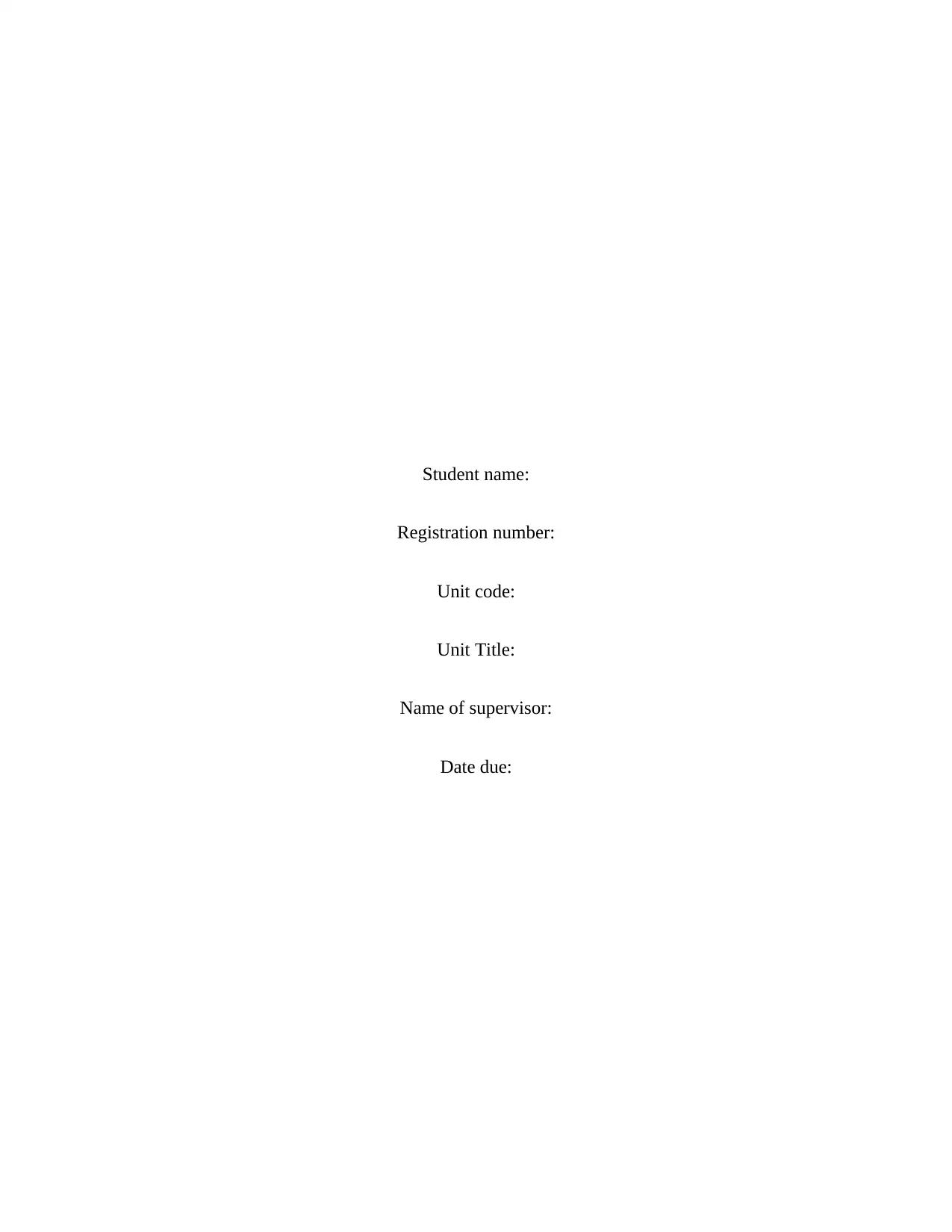
Student name:
Registration number:
Unit code:
Unit Title:
Name of supervisor:
Date due:
Registration number:
Unit code:
Unit Title:
Name of supervisor:
Date due:
Paraphrase This Document
Need a fresh take? Get an instant paraphrase of this document with our AI Paraphraser
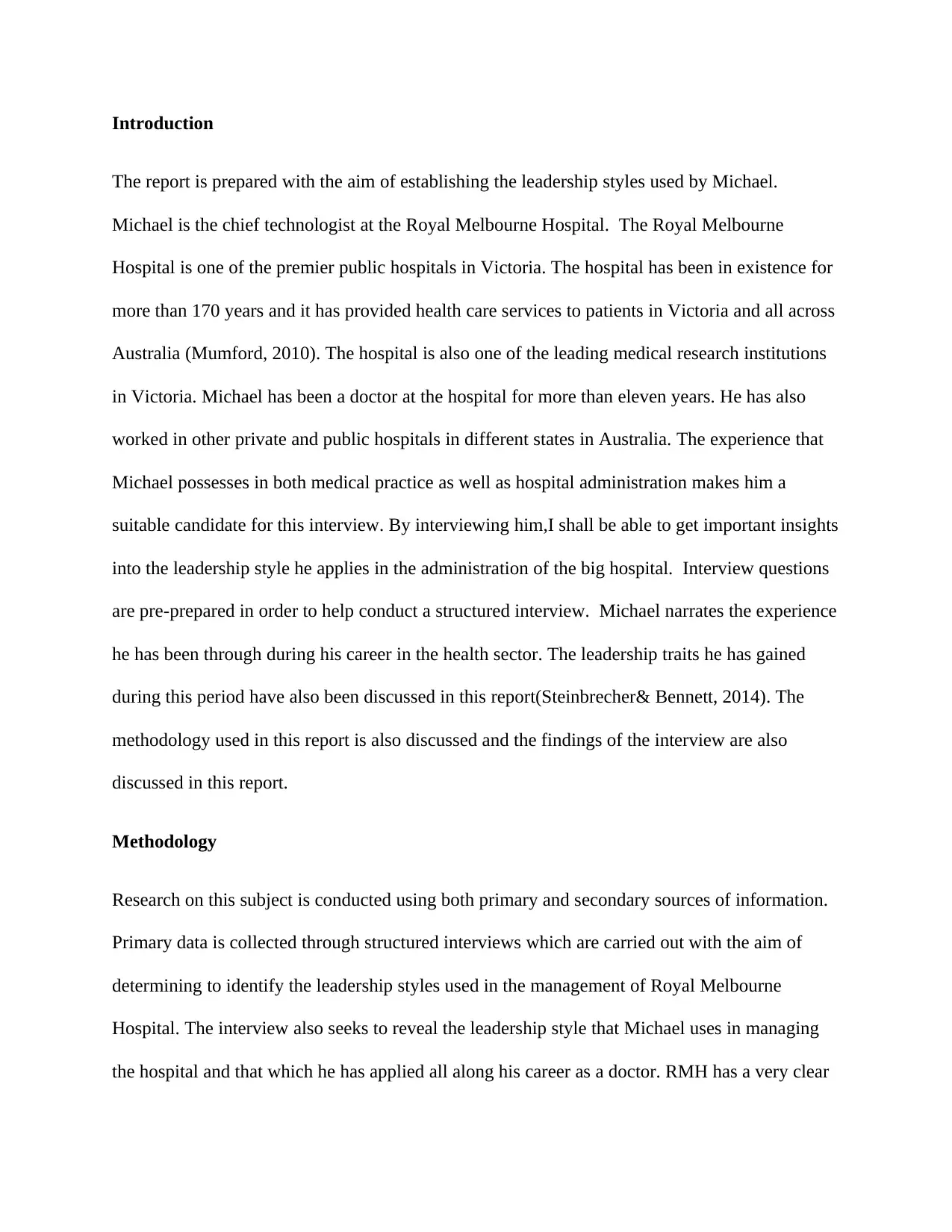
Introduction
The report is prepared with the aim of establishing the leadership styles used by Michael.
Michael is the chief technologist at the Royal Melbourne Hospital. The Royal Melbourne
Hospital is one of the premier public hospitals in Victoria. The hospital has been in existence for
more than 170 years and it has provided health care services to patients in Victoria and all across
Australia (Mumford, 2010). The hospital is also one of the leading medical research institutions
in Victoria. Michael has been a doctor at the hospital for more than eleven years. He has also
worked in other private and public hospitals in different states in Australia. The experience that
Michael possesses in both medical practice as well as hospital administration makes him a
suitable candidate for this interview. By interviewing him,I shall be able to get important insights
into the leadership style he applies in the administration of the big hospital. Interview questions
are pre-prepared in order to help conduct a structured interview. Michael narrates the experience
he has been through during his career in the health sector. The leadership traits he has gained
during this period have also been discussed in this report(Steinbrecher& Bennett, 2014). The
methodology used in this report is also discussed and the findings of the interview are also
discussed in this report.
Methodology
Research on this subject is conducted using both primary and secondary sources of information.
Primary data is collected through structured interviews which are carried out with the aim of
determining to identify the leadership styles used in the management of Royal Melbourne
Hospital. The interview also seeks to reveal the leadership style that Michael uses in managing
the hospital and that which he has applied all along his career as a doctor. RMH has a very clear
The report is prepared with the aim of establishing the leadership styles used by Michael.
Michael is the chief technologist at the Royal Melbourne Hospital. The Royal Melbourne
Hospital is one of the premier public hospitals in Victoria. The hospital has been in existence for
more than 170 years and it has provided health care services to patients in Victoria and all across
Australia (Mumford, 2010). The hospital is also one of the leading medical research institutions
in Victoria. Michael has been a doctor at the hospital for more than eleven years. He has also
worked in other private and public hospitals in different states in Australia. The experience that
Michael possesses in both medical practice as well as hospital administration makes him a
suitable candidate for this interview. By interviewing him,I shall be able to get important insights
into the leadership style he applies in the administration of the big hospital. Interview questions
are pre-prepared in order to help conduct a structured interview. Michael narrates the experience
he has been through during his career in the health sector. The leadership traits he has gained
during this period have also been discussed in this report(Steinbrecher& Bennett, 2014). The
methodology used in this report is also discussed and the findings of the interview are also
discussed in this report.
Methodology
Research on this subject is conducted using both primary and secondary sources of information.
Primary data is collected through structured interviews which are carried out with the aim of
determining to identify the leadership styles used in the management of Royal Melbourne
Hospital. The interview also seeks to reveal the leadership style that Michael uses in managing
the hospital and that which he has applied all along his career as a doctor. RMH has a very clear
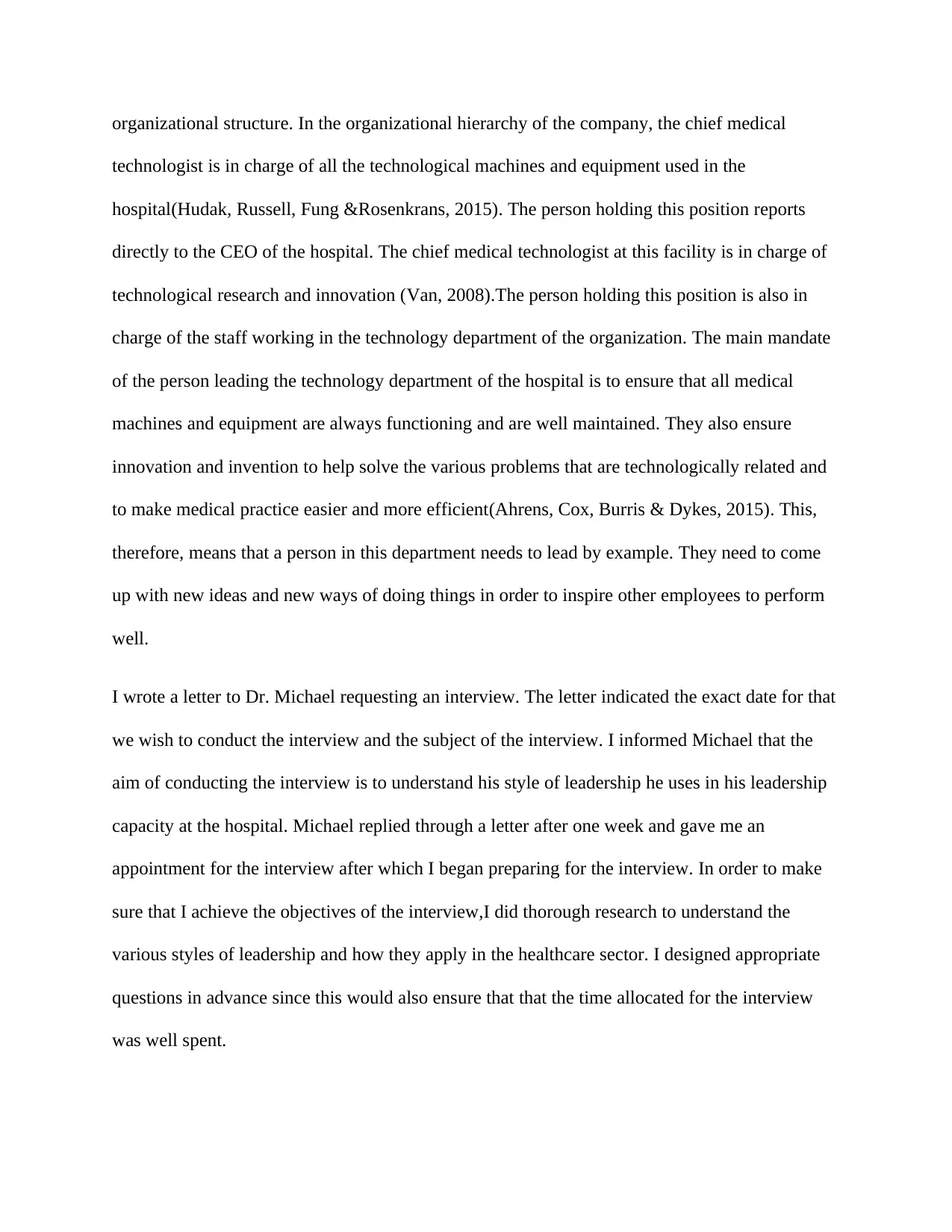
organizational structure. In the organizational hierarchy of the company, the chief medical
technologist is in charge of all the technological machines and equipment used in the
hospital(Hudak, Russell, Fung &Rosenkrans, 2015). The person holding this position reports
directly to the CEO of the hospital. The chief medical technologist at this facility is in charge of
technological research and innovation (Van, 2008).The person holding this position is also in
charge of the staff working in the technology department of the organization. The main mandate
of the person leading the technology department of the hospital is to ensure that all medical
machines and equipment are always functioning and are well maintained. They also ensure
innovation and invention to help solve the various problems that are technologically related and
to make medical practice easier and more efficient(Ahrens, Cox, Burris & Dykes, 2015). This,
therefore, means that a person in this department needs to lead by example. They need to come
up with new ideas and new ways of doing things in order to inspire other employees to perform
well.
I wrote a letter to Dr. Michael requesting an interview. The letter indicated the exact date for that
we wish to conduct the interview and the subject of the interview. I informed Michael that the
aim of conducting the interview is to understand his style of leadership he uses in his leadership
capacity at the hospital. Michael replied through a letter after one week and gave me an
appointment for the interview after which I began preparing for the interview. In order to make
sure that I achieve the objectives of the interview,I did thorough research to understand the
various styles of leadership and how they apply in the healthcare sector. I designed appropriate
questions in advance since this would also ensure that that the time allocated for the interview
was well spent.
technologist is in charge of all the technological machines and equipment used in the
hospital(Hudak, Russell, Fung &Rosenkrans, 2015). The person holding this position reports
directly to the CEO of the hospital. The chief medical technologist at this facility is in charge of
technological research and innovation (Van, 2008).The person holding this position is also in
charge of the staff working in the technology department of the organization. The main mandate
of the person leading the technology department of the hospital is to ensure that all medical
machines and equipment are always functioning and are well maintained. They also ensure
innovation and invention to help solve the various problems that are technologically related and
to make medical practice easier and more efficient(Ahrens, Cox, Burris & Dykes, 2015). This,
therefore, means that a person in this department needs to lead by example. They need to come
up with new ideas and new ways of doing things in order to inspire other employees to perform
well.
I wrote a letter to Dr. Michael requesting an interview. The letter indicated the exact date for that
we wish to conduct the interview and the subject of the interview. I informed Michael that the
aim of conducting the interview is to understand his style of leadership he uses in his leadership
capacity at the hospital. Michael replied through a letter after one week and gave me an
appointment for the interview after which I began preparing for the interview. In order to make
sure that I achieve the objectives of the interview,I did thorough research to understand the
various styles of leadership and how they apply in the healthcare sector. I designed appropriate
questions in advance since this would also ensure that that the time allocated for the interview
was well spent.
⊘ This is a preview!⊘
Do you want full access?
Subscribe today to unlock all pages.

Trusted by 1+ million students worldwide
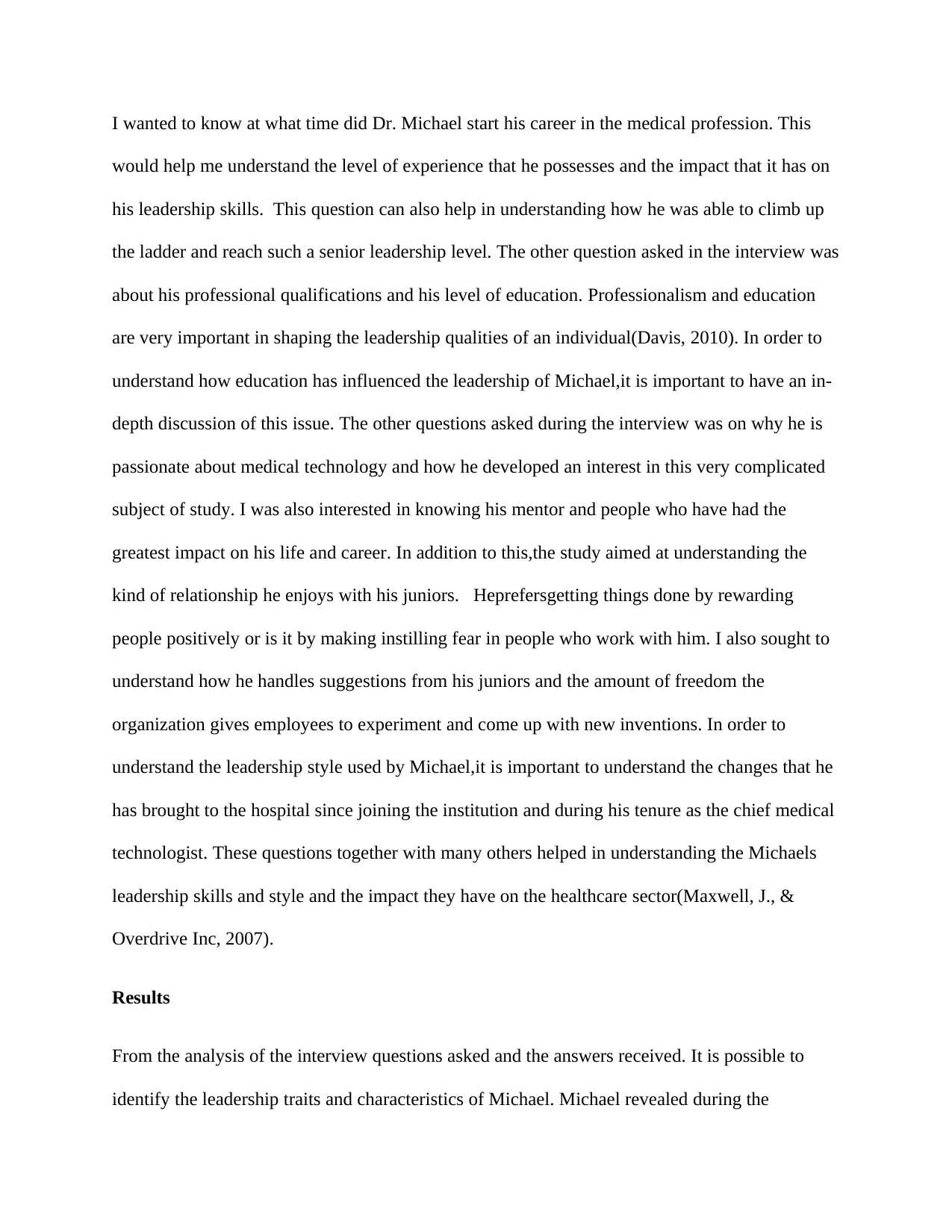
I wanted to know at what time did Dr. Michael start his career in the medical profession. This
would help me understand the level of experience that he possesses and the impact that it has on
his leadership skills. This question can also help in understanding how he was able to climb up
the ladder and reach such a senior leadership level. The other question asked in the interview was
about his professional qualifications and his level of education. Professionalism and education
are very important in shaping the leadership qualities of an individual(Davis, 2010). In order to
understand how education has influenced the leadership of Michael,it is important to have an in-
depth discussion of this issue. The other questions asked during the interview was on why he is
passionate about medical technology and how he developed an interest in this very complicated
subject of study. I was also interested in knowing his mentor and people who have had the
greatest impact on his life and career. In addition to this,the study aimed at understanding the
kind of relationship he enjoys with his juniors. Heprefersgetting things done by rewarding
people positively or is it by making instilling fear in people who work with him. I also sought to
understand how he handles suggestions from his juniors and the amount of freedom the
organization gives employees to experiment and come up with new inventions. In order to
understand the leadership style used by Michael,it is important to understand the changes that he
has brought to the hospital since joining the institution and during his tenure as the chief medical
technologist. These questions together with many others helped in understanding the Michaels
leadership skills and style and the impact they have on the healthcare sector(Maxwell, J., &
Overdrive Inc, 2007).
Results
From the analysis of the interview questions asked and the answers received. It is possible to
identify the leadership traits and characteristics of Michael. Michael revealed during the
would help me understand the level of experience that he possesses and the impact that it has on
his leadership skills. This question can also help in understanding how he was able to climb up
the ladder and reach such a senior leadership level. The other question asked in the interview was
about his professional qualifications and his level of education. Professionalism and education
are very important in shaping the leadership qualities of an individual(Davis, 2010). In order to
understand how education has influenced the leadership of Michael,it is important to have an in-
depth discussion of this issue. The other questions asked during the interview was on why he is
passionate about medical technology and how he developed an interest in this very complicated
subject of study. I was also interested in knowing his mentor and people who have had the
greatest impact on his life and career. In addition to this,the study aimed at understanding the
kind of relationship he enjoys with his juniors. Heprefersgetting things done by rewarding
people positively or is it by making instilling fear in people who work with him. I also sought to
understand how he handles suggestions from his juniors and the amount of freedom the
organization gives employees to experiment and come up with new inventions. In order to
understand the leadership style used by Michael,it is important to understand the changes that he
has brought to the hospital since joining the institution and during his tenure as the chief medical
technologist. These questions together with many others helped in understanding the Michaels
leadership skills and style and the impact they have on the healthcare sector(Maxwell, J., &
Overdrive Inc, 2007).
Results
From the analysis of the interview questions asked and the answers received. It is possible to
identify the leadership traits and characteristics of Michael. Michael revealed during the
Paraphrase This Document
Need a fresh take? Get an instant paraphrase of this document with our AI Paraphraser
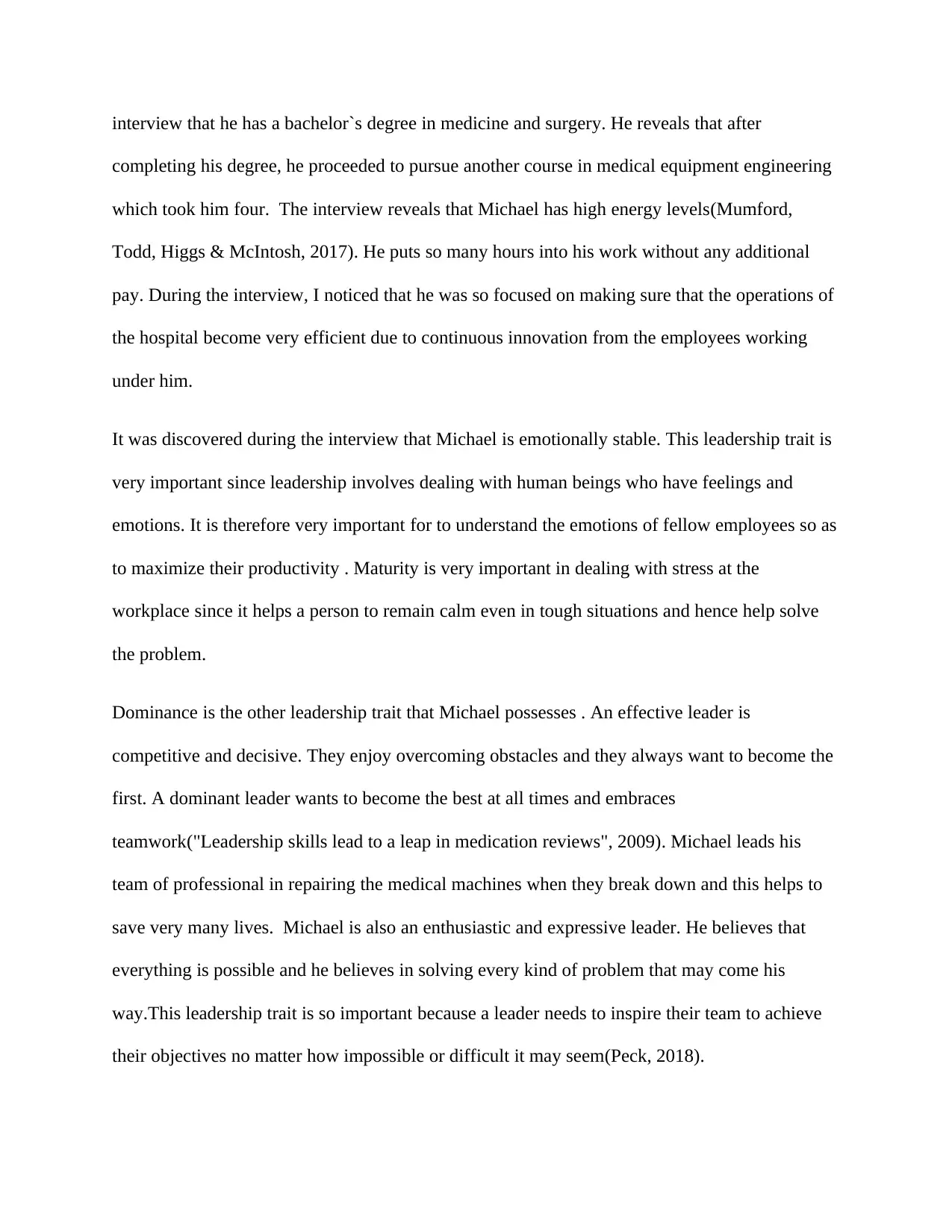
interview that he has a bachelor`s degree in medicine and surgery. He reveals that after
completing his degree, he proceeded to pursue another course in medical equipment engineering
which took him four. The interview reveals that Michael has high energy levels(Mumford,
Todd, Higgs & McIntosh, 2017). He puts so many hours into his work without any additional
pay. During the interview, I noticed that he was so focused on making sure that the operations of
the hospital become very efficient due to continuous innovation from the employees working
under him.
It was discovered during the interview that Michael is emotionally stable. This leadership trait is
very important since leadership involves dealing with human beings who have feelings and
emotions. It is therefore very important for to understand the emotions of fellow employees so as
to maximize their productivity . Maturity is very important in dealing with stress at the
workplace since it helps a person to remain calm even in tough situations and hence help solve
the problem.
Dominance is the other leadership trait that Michael possesses . An effective leader is
competitive and decisive. They enjoy overcoming obstacles and they always want to become the
first. A dominant leader wants to become the best at all times and embraces
teamwork("Leadership skills lead to a leap in medication reviews", 2009). Michael leads his
team of professional in repairing the medical machines when they break down and this helps to
save very many lives. Michael is also an enthusiastic and expressive leader. He believes that
everything is possible and he believes in solving every kind of problem that may come his
way.This leadership trait is so important because a leader needs to inspire their team to achieve
their objectives no matter how impossible or difficult it may seem(Peck, 2018).
completing his degree, he proceeded to pursue another course in medical equipment engineering
which took him four. The interview reveals that Michael has high energy levels(Mumford,
Todd, Higgs & McIntosh, 2017). He puts so many hours into his work without any additional
pay. During the interview, I noticed that he was so focused on making sure that the operations of
the hospital become very efficient due to continuous innovation from the employees working
under him.
It was discovered during the interview that Michael is emotionally stable. This leadership trait is
very important since leadership involves dealing with human beings who have feelings and
emotions. It is therefore very important for to understand the emotions of fellow employees so as
to maximize their productivity . Maturity is very important in dealing with stress at the
workplace since it helps a person to remain calm even in tough situations and hence help solve
the problem.
Dominance is the other leadership trait that Michael possesses . An effective leader is
competitive and decisive. They enjoy overcoming obstacles and they always want to become the
first. A dominant leader wants to become the best at all times and embraces
teamwork("Leadership skills lead to a leap in medication reviews", 2009). Michael leads his
team of professional in repairing the medical machines when they break down and this helps to
save very many lives. Michael is also an enthusiastic and expressive leader. He believes that
everything is possible and he believes in solving every kind of problem that may come his
way.This leadership trait is so important because a leader needs to inspire their team to achieve
their objectives no matter how impossible or difficult it may seem(Peck, 2018).
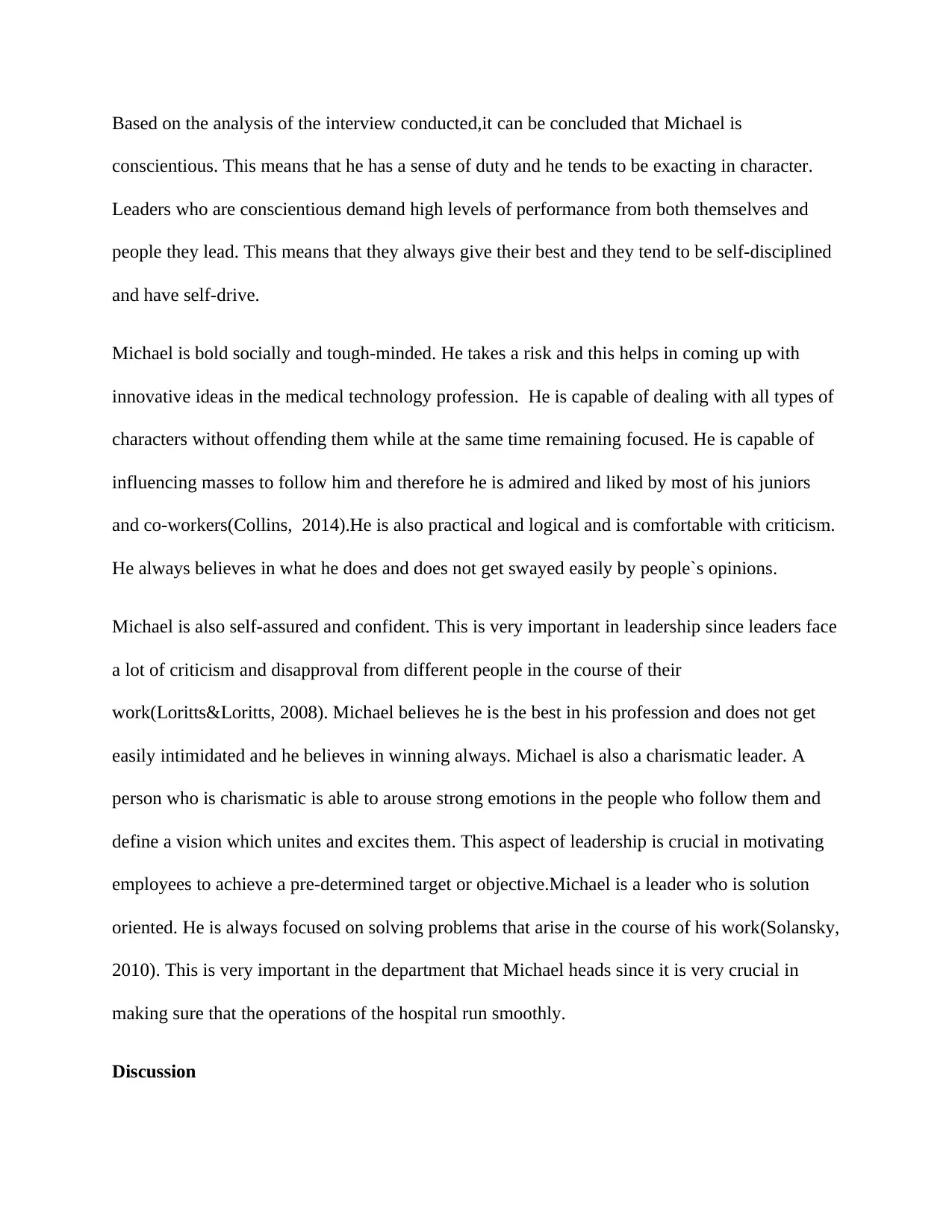
Based on the analysis of the interview conducted,it can be concluded that Michael is
conscientious. This means that he has a sense of duty and he tends to be exacting in character.
Leaders who are conscientious demand high levels of performance from both themselves and
people they lead. This means that they always give their best and they tend to be self-disciplined
and have self-drive.
Michael is bold socially and tough-minded. He takes a risk and this helps in coming up with
innovative ideas in the medical technology profession. He is capable of dealing with all types of
characters without offending them while at the same time remaining focused. He is capable of
influencing masses to follow him and therefore he is admired and liked by most of his juniors
and co-workers(Collins, 2014).He is also practical and logical and is comfortable with criticism.
He always believes in what he does and does not get swayed easily by people`s opinions.
Michael is also self-assured and confident. This is very important in leadership since leaders face
a lot of criticism and disapproval from different people in the course of their
work(Loritts&Loritts, 2008). Michael believes he is the best in his profession and does not get
easily intimidated and he believes in winning always. Michael is also a charismatic leader. A
person who is charismatic is able to arouse strong emotions in the people who follow them and
define a vision which unites and excites them. This aspect of leadership is crucial in motivating
employees to achieve a pre-determined target or objective.Michael is a leader who is solution
oriented. He is always focused on solving problems that arise in the course of his work(Solansky,
2010). This is very important in the department that Michael heads since it is very crucial in
making sure that the operations of the hospital run smoothly.
Discussion
conscientious. This means that he has a sense of duty and he tends to be exacting in character.
Leaders who are conscientious demand high levels of performance from both themselves and
people they lead. This means that they always give their best and they tend to be self-disciplined
and have self-drive.
Michael is bold socially and tough-minded. He takes a risk and this helps in coming up with
innovative ideas in the medical technology profession. He is capable of dealing with all types of
characters without offending them while at the same time remaining focused. He is capable of
influencing masses to follow him and therefore he is admired and liked by most of his juniors
and co-workers(Collins, 2014).He is also practical and logical and is comfortable with criticism.
He always believes in what he does and does not get swayed easily by people`s opinions.
Michael is also self-assured and confident. This is very important in leadership since leaders face
a lot of criticism and disapproval from different people in the course of their
work(Loritts&Loritts, 2008). Michael believes he is the best in his profession and does not get
easily intimidated and he believes in winning always. Michael is also a charismatic leader. A
person who is charismatic is able to arouse strong emotions in the people who follow them and
define a vision which unites and excites them. This aspect of leadership is crucial in motivating
employees to achieve a pre-determined target or objective.Michael is a leader who is solution
oriented. He is always focused on solving problems that arise in the course of his work(Solansky,
2010). This is very important in the department that Michael heads since it is very crucial in
making sure that the operations of the hospital run smoothly.
Discussion
⊘ This is a preview!⊘
Do you want full access?
Subscribe today to unlock all pages.

Trusted by 1+ million students worldwide
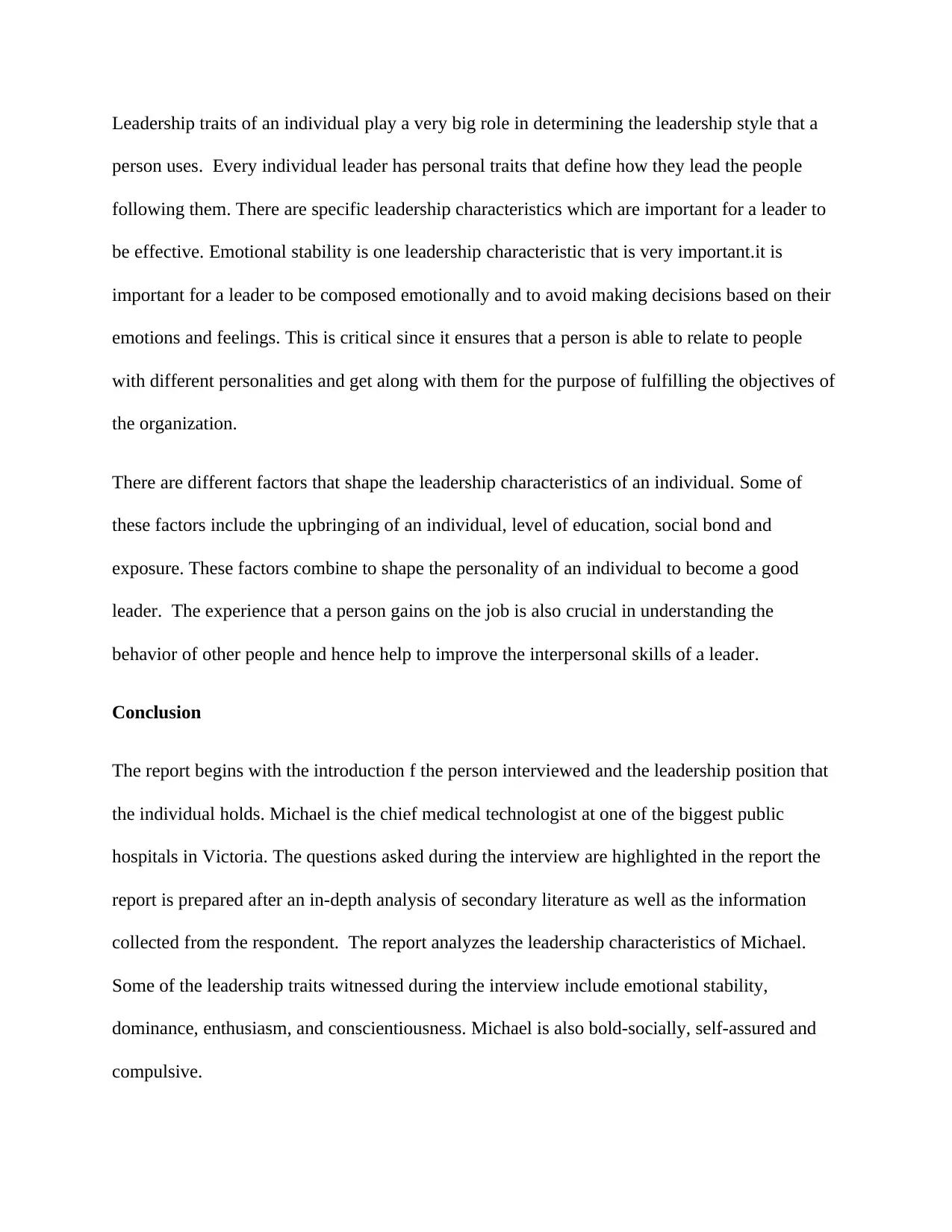
Leadership traits of an individual play a very big role in determining the leadership style that a
person uses. Every individual leader has personal traits that define how they lead the people
following them. There are specific leadership characteristics which are important for a leader to
be effective. Emotional stability is one leadership characteristic that is very important.it is
important for a leader to be composed emotionally and to avoid making decisions based on their
emotions and feelings. This is critical since it ensures that a person is able to relate to people
with different personalities and get along with them for the purpose of fulfilling the objectives of
the organization.
There are different factors that shape the leadership characteristics of an individual. Some of
these factors include the upbringing of an individual, level of education, social bond and
exposure. These factors combine to shape the personality of an individual to become a good
leader. The experience that a person gains on the job is also crucial in understanding the
behavior of other people and hence help to improve the interpersonal skills of a leader.
Conclusion
The report begins with the introduction f the person interviewed and the leadership position that
the individual holds. Michael is the chief medical technologist at one of the biggest public
hospitals in Victoria. The questions asked during the interview are highlighted in the report the
report is prepared after an in-depth analysis of secondary literature as well as the information
collected from the respondent. The report analyzes the leadership characteristics of Michael.
Some of the leadership traits witnessed during the interview include emotional stability,
dominance, enthusiasm, and conscientiousness. Michael is also bold-socially, self-assured and
compulsive.
person uses. Every individual leader has personal traits that define how they lead the people
following them. There are specific leadership characteristics which are important for a leader to
be effective. Emotional stability is one leadership characteristic that is very important.it is
important for a leader to be composed emotionally and to avoid making decisions based on their
emotions and feelings. This is critical since it ensures that a person is able to relate to people
with different personalities and get along with them for the purpose of fulfilling the objectives of
the organization.
There are different factors that shape the leadership characteristics of an individual. Some of
these factors include the upbringing of an individual, level of education, social bond and
exposure. These factors combine to shape the personality of an individual to become a good
leader. The experience that a person gains on the job is also crucial in understanding the
behavior of other people and hence help to improve the interpersonal skills of a leader.
Conclusion
The report begins with the introduction f the person interviewed and the leadership position that
the individual holds. Michael is the chief medical technologist at one of the biggest public
hospitals in Victoria. The questions asked during the interview are highlighted in the report the
report is prepared after an in-depth analysis of secondary literature as well as the information
collected from the respondent. The report analyzes the leadership characteristics of Michael.
Some of the leadership traits witnessed during the interview include emotional stability,
dominance, enthusiasm, and conscientiousness. Michael is also bold-socially, self-assured and
compulsive.
Paraphrase This Document
Need a fresh take? Get an instant paraphrase of this document with our AI Paraphraser
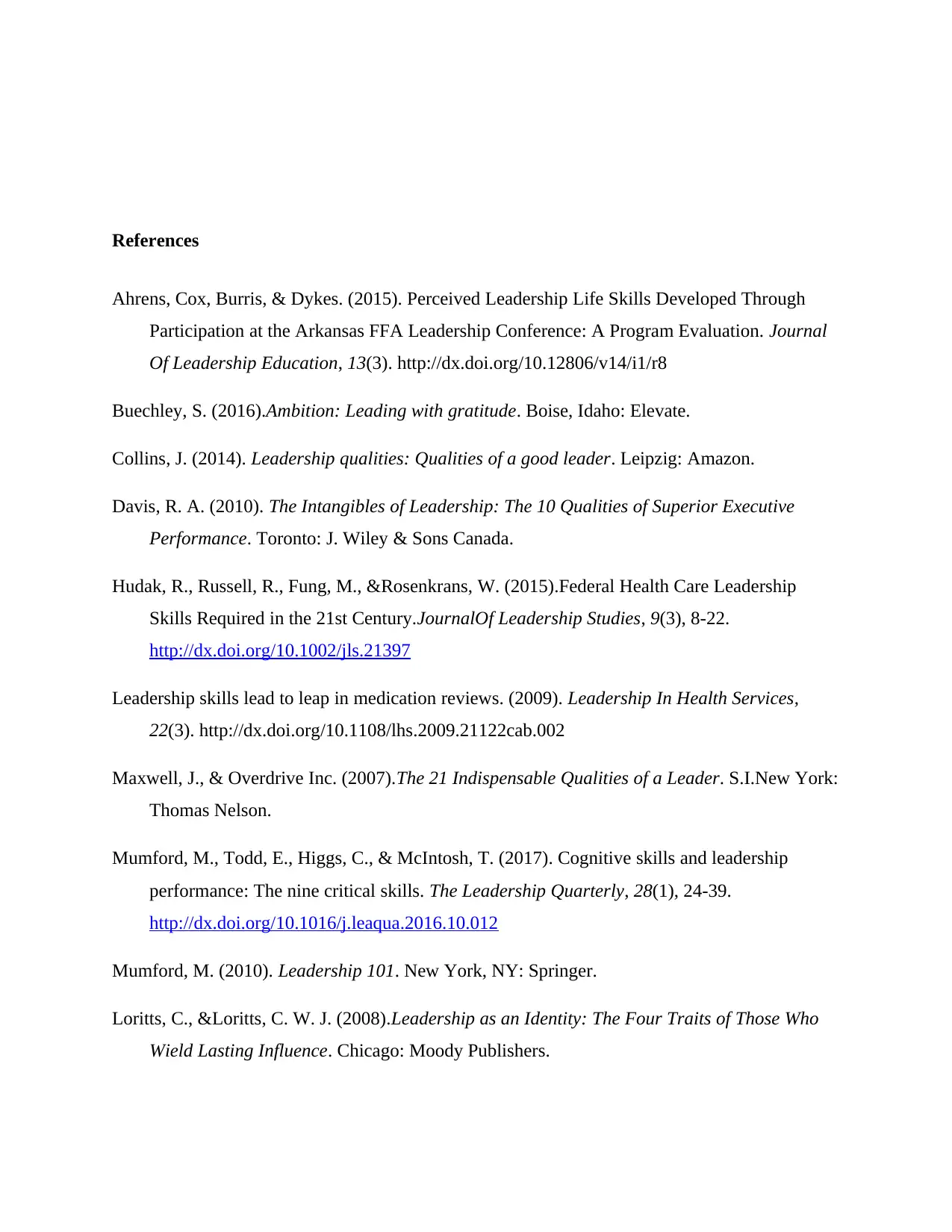
References
Ahrens, Cox, Burris, & Dykes. (2015). Perceived Leadership Life Skills Developed Through
Participation at the Arkansas FFA Leadership Conference: A Program Evaluation. Journal
Of Leadership Education, 13(3). http://dx.doi.org/10.12806/v14/i1/r8
Buechley, S. (2016).Ambition: Leading with gratitude. Boise, Idaho: Elevate.
Collins, J. (2014). Leadership qualities: Qualities of a good leader. Leipzig: Amazon.
Davis, R. A. (2010). The Intangibles of Leadership: The 10 Qualities of Superior Executive
Performance. Toronto: J. Wiley & Sons Canada.
Hudak, R., Russell, R., Fung, M., &Rosenkrans, W. (2015).Federal Health Care Leadership
Skills Required in the 21st Century.JournalOf Leadership Studies, 9(3), 8-22.
http://dx.doi.org/10.1002/jls.21397
Leadership skills lead to leap in medication reviews. (2009). Leadership In Health Services,
22(3). http://dx.doi.org/10.1108/lhs.2009.21122cab.002
Maxwell, J., & Overdrive Inc. (2007).The 21 Indispensable Qualities of a Leader. S.I.New York:
Thomas Nelson.
Mumford, M., Todd, E., Higgs, C., & McIntosh, T. (2017). Cognitive skills and leadership
performance: The nine critical skills. The Leadership Quarterly, 28(1), 24-39.
http://dx.doi.org/10.1016/j.leaqua.2016.10.012
Mumford, M. (2010). Leadership 101. New York, NY: Springer.
Loritts, C., &Loritts, C. W. J. (2008).Leadership as an Identity: The Four Traits of Those Who
Wield Lasting Influence. Chicago: Moody Publishers.
Ahrens, Cox, Burris, & Dykes. (2015). Perceived Leadership Life Skills Developed Through
Participation at the Arkansas FFA Leadership Conference: A Program Evaluation. Journal
Of Leadership Education, 13(3). http://dx.doi.org/10.12806/v14/i1/r8
Buechley, S. (2016).Ambition: Leading with gratitude. Boise, Idaho: Elevate.
Collins, J. (2014). Leadership qualities: Qualities of a good leader. Leipzig: Amazon.
Davis, R. A. (2010). The Intangibles of Leadership: The 10 Qualities of Superior Executive
Performance. Toronto: J. Wiley & Sons Canada.
Hudak, R., Russell, R., Fung, M., &Rosenkrans, W. (2015).Federal Health Care Leadership
Skills Required in the 21st Century.JournalOf Leadership Studies, 9(3), 8-22.
http://dx.doi.org/10.1002/jls.21397
Leadership skills lead to leap in medication reviews. (2009). Leadership In Health Services,
22(3). http://dx.doi.org/10.1108/lhs.2009.21122cab.002
Maxwell, J., & Overdrive Inc. (2007).The 21 Indispensable Qualities of a Leader. S.I.New York:
Thomas Nelson.
Mumford, M., Todd, E., Higgs, C., & McIntosh, T. (2017). Cognitive skills and leadership
performance: The nine critical skills. The Leadership Quarterly, 28(1), 24-39.
http://dx.doi.org/10.1016/j.leaqua.2016.10.012
Mumford, M. (2010). Leadership 101. New York, NY: Springer.
Loritts, C., &Loritts, C. W. J. (2008).Leadership as an Identity: The Four Traits of Those Who
Wield Lasting Influence. Chicago: Moody Publishers.
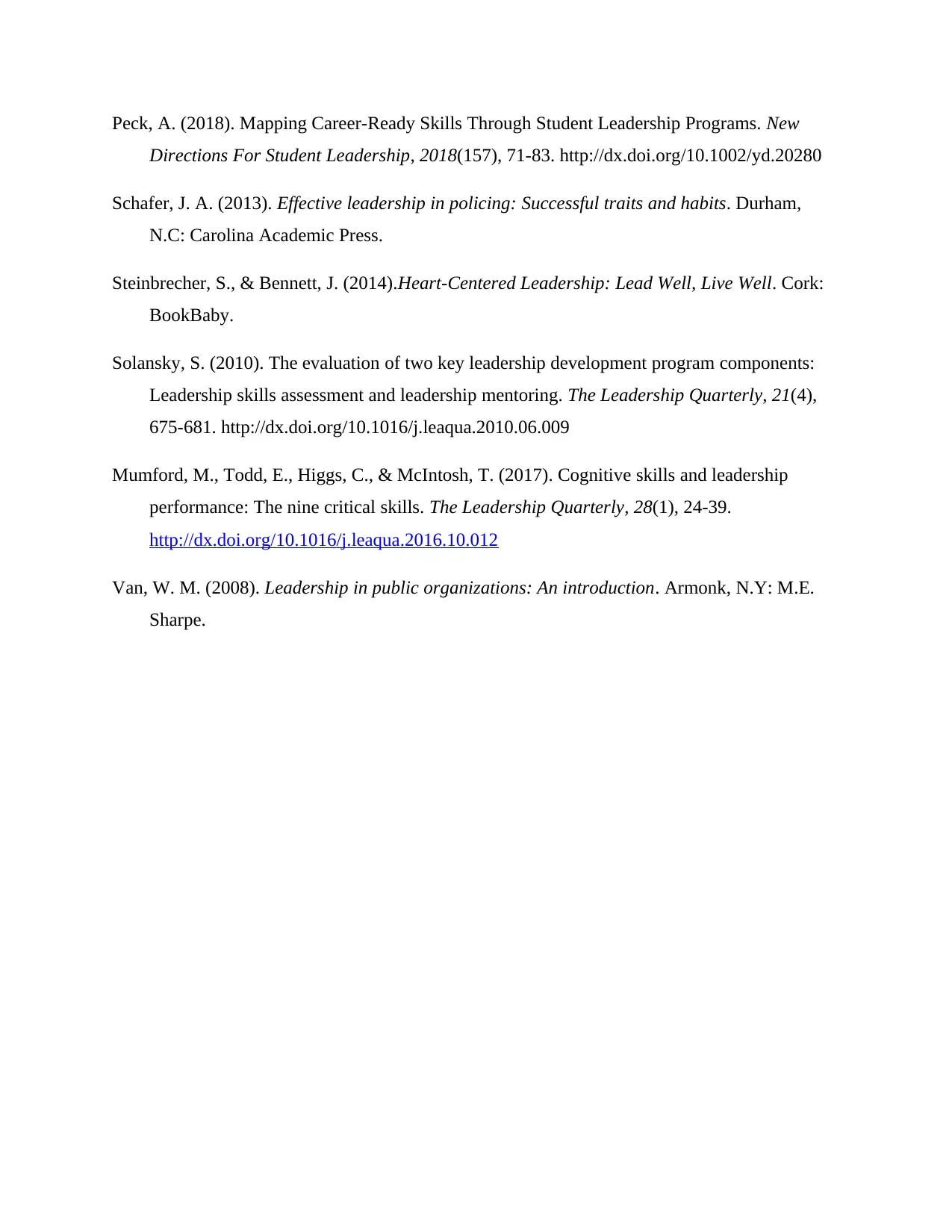
Peck, A. (2018). Mapping Career-Ready Skills Through Student Leadership Programs. New
Directions For Student Leadership, 2018(157), 71-83. http://dx.doi.org/10.1002/yd.20280
Schafer, J. A. (2013). Effective leadership in policing: Successful traits and habits. Durham,
N.C: Carolina Academic Press.
Steinbrecher, S., & Bennett, J. (2014).Heart-Centered Leadership: Lead Well, Live Well. Cork:
BookBaby.
Solansky, S. (2010). The evaluation of two key leadership development program components:
Leadership skills assessment and leadership mentoring. The Leadership Quarterly, 21(4),
675-681. http://dx.doi.org/10.1016/j.leaqua.2010.06.009
Mumford, M., Todd, E., Higgs, C., & McIntosh, T. (2017). Cognitive skills and leadership
performance: The nine critical skills. The Leadership Quarterly, 28(1), 24-39.
http://dx.doi.org/10.1016/j.leaqua.2016.10.012
Van, W. M. (2008). Leadership in public organizations: An introduction. Armonk, N.Y: M.E.
Sharpe.
Directions For Student Leadership, 2018(157), 71-83. http://dx.doi.org/10.1002/yd.20280
Schafer, J. A. (2013). Effective leadership in policing: Successful traits and habits. Durham,
N.C: Carolina Academic Press.
Steinbrecher, S., & Bennett, J. (2014).Heart-Centered Leadership: Lead Well, Live Well. Cork:
BookBaby.
Solansky, S. (2010). The evaluation of two key leadership development program components:
Leadership skills assessment and leadership mentoring. The Leadership Quarterly, 21(4),
675-681. http://dx.doi.org/10.1016/j.leaqua.2010.06.009
Mumford, M., Todd, E., Higgs, C., & McIntosh, T. (2017). Cognitive skills and leadership
performance: The nine critical skills. The Leadership Quarterly, 28(1), 24-39.
http://dx.doi.org/10.1016/j.leaqua.2016.10.012
Van, W. M. (2008). Leadership in public organizations: An introduction. Armonk, N.Y: M.E.
Sharpe.
⊘ This is a preview!⊘
Do you want full access?
Subscribe today to unlock all pages.

Trusted by 1+ million students worldwide
1 out of 9
Related Documents
Your All-in-One AI-Powered Toolkit for Academic Success.
+13062052269
info@desklib.com
Available 24*7 on WhatsApp / Email
![[object Object]](/_next/static/media/star-bottom.7253800d.svg)
Unlock your academic potential
Copyright © 2020–2025 A2Z Services. All Rights Reserved. Developed and managed by ZUCOL.





